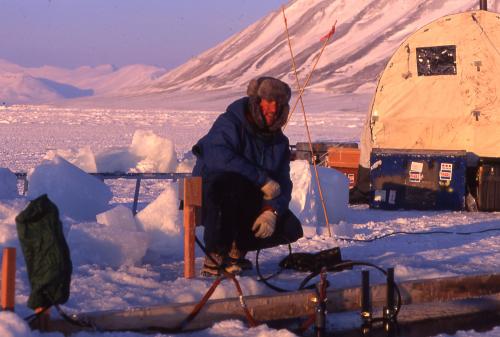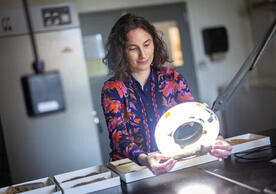
Summer field season is in full swing at Yale - stay tuned for updates from YIBS students and faculty in the field. In the meantime, explore the work of Spring 2016 Bass Visiting Environmental Scholar Dr. Grae Worster, Professor of Fluid Dynamics at the University of Cambridge, Trinity College Senior Lecturer in Mathematics for Natural Sciences.
by Juliana Hanle, YIBS Science Communication Fellow (juliana.hanle@yale.edu)
Dr. Worster’s work has taken him from the ice-fields of Svalbard to the labs of Cambridge and Yale. He examines and models “mushy layers:” the places of transition from solid to fluid. His subjects range from frost-heave in soil to micro-porous materials for industrial use. Dr. Worster addressed YIBS affiliates in a recent Friday seminar, discussing brine channels and buoyancy dynamics in sea-ice—work that will, ultimately, inform global climate models. Dr. Worster’s work has implications for events from fracking to climate change. We asked Dr. Worster how he turns melting ice into math. Here are some of his comments.
YIBS: What first attracted you to research?
GW: I grew up near the sea and was always fascinated by it, so I was naturally attracted by courses in fluid dynamics as a student.
Some questions seem fascinating because they involve patterns—some mathematicians look at a snowflake and think “oh, doesn’t that look like a fractal.” But by the time you’re skiing on the snow you don’t care about the snowflake patterns, what you do care about is their size and the volume of ice they encompass. These are the questions that interest me.
YIBS: You study mushy layers in both the ocean and earth. What drives them in sea-ice?
GW: The evolution of the mushy layer is affected by convection and internal dissolution, which is what makes it complicated and interesting. It’s the convection inside sea ice that gives rise to brine channels, the dissolution channels through which the brine emerges into the ocean. Without the convection, the rejected salt would simply remain within the pores of the mushy sea ice.
YIBS: What do you enjoy most about the work?
GW: I think what I enjoy is getting to grips with physical problems using simple mathematical models.
YIBS: How simple is “simple”?
GW: There is quite a range, the simplest form is quite low-order ordinary differential equations. Two or three orders. At the other end, partial differential equations that I look at can have quite high orders, up to thirteen or so. It’s all about trying to investigate fundamental ideas with the simplest mathematical models that focus on and identify the significance of physical interactions.
Free boundaries are where the biggest mathematical challenges lie: the boundary between solid and liquid has to be predicted along with the solution of the differential equations on either side. With the solid–liquid interface it’s fairly straightforward, the motion of the boundary is governed by thermodynamics. At the boundary of a mushy layer we’re looking at the interface between an averaged medium of co-existing solid and liquid and a continuous medium of just liquid. The boundary is quite hard to define so what one ends up with generally are jump conditions that relate properties on either side of a somewhat broad interfacial region.
YIBS: What might be a jump condition?
GW: You might find that the solid fraction varies discontinuously across the notional interface between mush and liquid.
YIBS: Where is this work now?
GW: Encapsulating our understanding of the internal dynamics of mushy layers into a one-dimensional model of sea-ice that is cheap enough to incorporate into a climate model. Computationally cheap enough to use.
YIBS: Can we see free boundaries in everyday things, like frozen puddles or yogurt?
GW: Yes indeed, we can see interfaces in all sorts of things. The surface of your coffee is a sharp interface where phase change, evaporation, is taking place, and your yogurt example is a good case of a mixed-phase region of liquid and solid particles, the curds, separated from a continuous liquid region, the whey—just like the interface between a mushy layer and a liquid.
While at Yale, Dr. Worster focused on collaborating with university researchers, particularly in the study of poro-elastic materials.
Read more about Dr. Worster’s work.
Learn more about the YIBS Bass Visiting Environmental Scholars Program.



